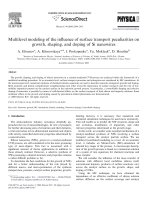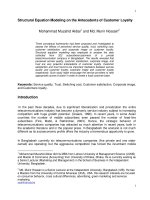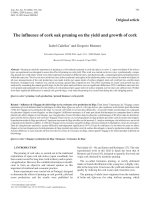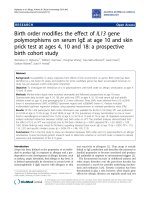Testing the influence of factors of customer relationship management on customer loyalty at vietcombank dong nai branch
Bạn đang xem bản rút gọn của tài liệu. Xem và tải ngay bản đầy đủ của tài liệu tại đây (784.48 KB, 98 trang )
MINISTRY OF EDUCATION AND TRAINING
UNIVERSITY OF ECONOMICS HOCHIMINH CITY
Nguyễn Anh Đức
TESTING THE INFLUENCE OF
FACTORS OF CUSTOMER RELATIONSHIP MANAGEMENT
ON CUSTOMER LOYALTY
AT VIETCOMBANK DONG NAI BRANCH
MASTER THESIS
Ho Chi Minh City, 2011
MINISTRY OF EDUCATION AND TRAINING
UNIVERSITY OF ECONOMICS HOCHIMINH CITY
Nguyễn Anh Đức
TESTING THE INFLUENCE OF
FACTORS OF CUSTOMER RELATIONSHIP MANAGEMENT
ON CUSTOMER LOYALTY
AT VIETCOMBANK DONG NAI BRANCH
In Banking course: 17
Ology code: 60.31.12
MASTER THESIS
Supervisor:
Professor, Ph.D, Nguyễn Đông Phong
Ho Chi Minh City, 2011
i
ACKNOWLEDGEMENT
I would like to express my sincere gratitude to following people for their
contribution to my thesis:
My academic advisor Professor, Ph.D. Nguyen Dong Phong for his help, advice and
knowledge.
Ph.D. Tran Ha Minh Quan for his guideline in study.
Mr. Dang Huu Phuc for his assistance with the data processing.
All of my classmates in Banking course 17 for supporting and corporating with me
during this course.
My colleagues at Vietcombank Dong nai for their great support in collecting data.
Respondents, without them, my thesis could not have been done.
My family and friends, for supporting and motivating me.
Thanks again for above all, who gave me the strength and courage to complete this
thesis.
ii
ABSTRACT
The rapid development of Vietcombank Dong Nai in recent years has raised
several problems, customers complain more about banking services, employees
attitude and employees knowledge. And as a result, some of them have left
Vietcombank Dong Nai and closed their accounts and moved to another banks.
Therefore, in order to keep the stable development and ensure the effeciency of
business, Vietcombank should soon find solutions to solve this problem. In other
words, Vietcombank Dong nai should build a customer base to form their loyalty.
This study attempts to examine the aspect of Customer Relationship
Management (CRM) at Vietcombank Dong Nai. Specifically, it tries to identify
independent variables of CRM which may influence on customer loyalty, which is
considered as an dependent variable. These independent variables includes: Twoway communication, Employees Attitude, Employees knowledge and the Efficiency
of banking services.
In order to gather data, a survey was conducted at Vietcombank Dong Nai, the
sample consists of customers there with sample sizes of 205, the responsive rate is
77.90%. The result of realibility testing Cronbach Alpha and factor analysis help to
affirm the comformity of measurement scales with the study objectives. By testing
hypotheses with multiple regression analysis, this study point out that there exists a
relationship between independent variables and dependent variable. In addition,
coefficient beta of independent variables help to determine the degree of influence
of each variables to customer loyalty.
From these findings in data analysis, this study also offers some
recommendation, that Vietcombank Dong Nai should spend more resources in order
to improve employees attitude and two-way communication in order to ensure
customer loyalty to the bank.
iii
TABLE OF CONTENTS
ACKNOWLEDGEMENT ........................................................................................... i
ABSTRACT ............................................................................................................... ii
TABLE OF CONTENTS .......................................................................................... iii
LIST OF FIGURES ................................................................................................. viii
LIST OF TABLES ..................................................................................................... x
CHAPTER 1: INTRODUCTION TO THE STUDY ................................................. 1
1.1 Introduction ....................................................................................................... 1
1.2 Research background ........................................................................................ 1
1.3 Overview of Vietcombank Dong Nai ............................................................... 3
1.4 Research Problem ............................................................................................. 7
1.5 Research questions ............................................................................................ 8
1.6 Problem statement............................................................................................. 8
1.6 Study scope ....................................................................................................... 9
1.7 Research methods ............................................................................................. 9
1.8 Structure of the study ........................................................................................ 9
CHAPTER 2: LITERATURE REVIEW.................................................................. 11
2.1 Introduction ..................................................................................................... 11
2.2 Customer loyalty ............................................................................................. 11
2.2.1 Customer loyalty to bank ......................................................................... 12
2.2.2 Measuring customer loyalty ..................................................................... 13
iv
2.3 Customer Relationship Management .............................................................. 13
2.3.1 Defining Customer Relationship Management ........................................ 14
2.3.2 Benefit of Customer Relationship Management ...................................... 15
2.3.3 The components of CRM ......................................................................... 17
2.3.3.1 Two-way communication ..................................................................... 18
2.3.3.2 Employees’ Attitude ............................................................................. 19
2.3.3.3 Employees’ knowledge ......................................................................... 20
2.3.3.4 Efficiency of banking services .............................................................. 21
2.4 Relationship between CRM and customer loyalty ......................................... 24
2.4.1 The influence of two-way communication on customer loyalty ............. 25
2.4.2 The influence of employees’ attitude on customer loyalty ...................... 25
2.4.3 The influence of employees’ knowledge on customer loyalty ................ 26
2.4.4 The influence of the efficiency of banking services on customer loyalty 26
2.5 Conclusion ...................................................................................................... 27
CHAPTER 3: RESEARCH METHODOLOGY ...................................................... 28
3.1 Introduction ..................................................................................................... 28
3.2 Business research ............................................................................................ 29
3.3 Research design .............................................................................................. 30
3.4 Research objectives......................................................................................... 31
3.5 Generation of hypotheses................................................................................ 32
v
3.5.1 Hypotheses of relationship between the independent variables and the
dependent variable .................................................................................. 33
3.5.2 Hypotheses of relationship between each independent variables and the
dependent variable .................................................................................. 34
3.5.3 Hypotheses of relationship between the biographic variables and the
dependent variable .................................................................................. 34
3.6 Data collection method ................................................................................... 35
3.7 Measurement instrument................................................................................. 35
3.8 Measurement scales ........................................................................................ 36
3.8.1 Items measuring Two way communication ............................................. 36
3.8.2 Items measuring Employee attitude ......................................................... 37
3.8.3 Items measuring Employees knowledge .................................................. 38
3.8.4 Items measuring Efficiency of banking services ..................................... 39
3.8.5 Items measuring Customer loyalty: ......................................................... 41
3.9 Pilot test .......................................................................................................... 41
3.10 Data analysis ................................................................................................. 42
3.10.1 Sampling ................................................................................................ 44
3.10.2 Sample size............................................................................................. 45
3.11 Conclusion .................................................................................................... 45
CHAPTER 4: DATA ANALYSIS AND FINDINGS .......................................... 46
4.1 Introduction ................................................................................................... 46
vi
4.2 Description of collected samples ................................................................... 46
4.2.1 Sex of respondents ................................................................................... 47
4.2.2 Age group of respondents ........................................................................ 47
4.2.3 Years of being customer of Vietcombank Dong Nai ............................... 48
4.2.4 Education level of respondents ................................................................ 49
4.3 Assessing measurement scale ........................................................................ 49
4.3.1 Reliability of Two-way communication items ........................................ 50
4.3.2 Reliability of Employees attitude items ................................................... 51
4.3.3 Reliability of Employees knowledge items ............................................. 51
4.3.4 Reliability of Efficiency of banking services items ................................. 52
4.3.5 Reliability of Customer loyalty items ...................................................... 53
4.4 Exploratory factor analysis ............................................................................. 54
4.4.1 Analyzing independent variables ............................................................. 54
4.4.2 Analyzing dependent variable - Customer loyalty................................... 59
4.5 Multiple regression analysis .......................................................................... 60
4.5.1 Testing the conformity of research model ............................................... 60
4.5.2 Detecting multicollinearity phenomenon ................................................. 61
4.5.3 Testing hypotheses of relationship between the independent variables and
the dependent variable ............................................................................ 62
4.5.4 Analysis of variance test of biographic variables and customer loyalty.. 64
vii
4.6 The empirical model ...................................................................................... 66
4.7 Conclusion ..................................................................................................... 67
CHAPTER 5: CONCLUSIONS AND RECOMMENDATIONS ...................... 69
5.1 Introduction ..................................................................................................... 69
5.2 Summary of study ........................................................................................... 69
5.2.1 Summary of factor analysis and testing hypotheses results ..................... 70
5.2.2 Findings and recommendations of the study............................................ 71
5.3 Study limitations ............................................................................................. 73
5.4 Areas for future research................................................................................. 74
5.5 Final conclusions ............................................................................................ 74
LIST OF REFERENCES....................................................................................... 75
APPENDIX - Questionaires (Vietnamese version).............................................. 78
viii
LIST OF FIGURES
Figure 1.1: The outline of Chapter 1 .......................................................................... 1
Figure 1.2: Vietcombank Dong Nai overview ........................................................... 3
Figure 1.3: Deposit and Debt outstanding from 2007 to Nov, 2011 .......................... 4
Figure 1.4: Export and Import turnover from 2007 to Nov,2011............................... 4
Figure 1.5: Number of ATM cards from 2007 to Nov, 2011 ..................................... 5
Figure 1.6: Number of credit cards from 2007 to Nov, 2011 ..................................... 5
Figure 1.7: The business result from 2007 to Nov, 2011 ........................................... 6
Figure 1.8: Structure of the study ............................................................................. 10
Figure 2.1: The outline of Chapter 2 ........................................................................ 11
Figure 2.2: The components of CRM ....................................................................... 17
Figure 2.3: Conceptual research model .................................................................... 27
Figure 3.1: The outline of chapter 3 ......................................................................... 28
Figure 3.2: Research model ...................................................................................... 33
Figure 4.1: The outline of Chapter four.................................................................... 46
Figure 4.2: Sex of respondents ................................................................................. 47
Figure 4.3: Age group of respondents ...................................................................... 47
Figure 4.4: Years of being customer of Vietcombank Dong Nai ............................. 48
Figure 4.5: Education level of respondents .............................................................. 49
Figure 4.6: Empirical model ..................................................................................... 67
ix
Figure 5.1 The outline of Chapter five ..................................................................... 69
x
LIST OF TABLES
Table 3.1: Items measuring Two way communication ............................................ 36
Table 3.2: Items measuring Employees Attitude ..................................................... 37
Table 3.3: Items measuring Employees knowledge ................................................. 39
Table 3.4: Items measuring Efficiency of banking services .................................... 40
Table 3.5: Items measuring Customer loyalty.......................................................... 41
Table 4.1: Cronbach’s Alpha of Two-way communication ..................................... 50
Table 4.2: Cronbach’s Alpha of Two-way communication if item deleted ............. 50
Table 4.3: Cronbach’s Alpha of Employees attitude ............................................... 51
Table 4.4: Cronbach’s Alpha of Employees attitude if item deleted ....................... 51
Table 4.5: Cronbach’s Alpha of Employees knowledge .......................................... 52
Table 4.6: Cronbach’s Alpha of Employees knowledge if item deleted .................. 52
Table 4.7: Cronbach’s Alpha of Efficiency of banking services ............................. 52
Table 4.8: Cronbach’s Alpha of Efficiency of banking services if item deleted ..... 53
Table 4.9: Cronbach’s Alpha of Customer loyalty items ......................................... 54
Table 4.10: Cronbach’s Alpha of Customer loyalty if item deleted ........................ 54
Table 4.11: KMO and Bartlett's Test........................................................................ 55
Table 4.12: Total Variance Explained ...................................................................... 56
Table 4.13: Rotated Component Matrixa .................................................................. 58
Table 4.14: Component Matrixa ............................................................................... 60
xi
Table 4.15: Model Summary .................................................................................... 61
Table 4.16: Table ANOVAb ..................................................................................... 61
Table 4.17: Coefficientsa .......................................................................................... 62
Table 4.18: Coefficientsa .......................................................................................... 63
Table 4.19 : ANOVA test between SEX and LOY .................................................. 64
Table 4.20 : ANOVA test between AGE and LOY ................................................. 65
Table 4.21 : ANOVA test between YEARS OF BEING CUSTOMER and LOY .. 65
Table 4.22 : ANOVA test between EDUCATION and LOY .................................. 65
Table 4.23: Descriptives between AGE and LOY ................................................... 66
Table 5.1: Remaining loading items ......................................................................... 70
Table 5.2: Testing hypotheses results ....................................................................... 71
Table 5.3: Coefficientsa ............................................................................................ 72
1
CHAPTER 1: INTRODUCTION TO THE STUDY
1.1 Introduction
The objective of this chapter is to provide a general introduction to the
research study and to establish work flow for the study as a whole, by providing a
general picture of the study. This chapter is organized into seven sections as shown
below:
Figure 1.1: The outline of Chapter 1
1.2 Research background
Vietnamese banks have traditionally operated in a relatively stable
environment for decades. However, today the banking industry is facing a
dramatically aggressive competition in a new deregulated environment. The State
Bank of Vietnam has granted permission for several Joint Stock banks and equitized
quite a number of state banks which further increases the competition and
complexity among the banks. The net result of the recent competition and
2
legislation is that traditional banks like Vietcombank have lost a substantial
proportion of their customers to other banks. Competition will undoubtedly
continue to be a unvoidably significant factor.
Banks in Vietnam begin to realize that no bank can offer all products and
become the leading bank for all customers. They are forced to find a new basis for
competition and they have to improve the quality of their own products and
services. In other words, banks have to create the customer relationship that deliver
value beyond that provided by the core product.
In addition, the needs and requirements of customers for banking services
have also become more complex, they have become more knowledgeable,
sophisticated, and assertive on where to make banking transactions. They demand
higher levels of customer service, are less loyal, and more inclined to switch to a
competitor. To ensure the banks’ survival in the face of fierce competition,
Vietnamese banks are trying their best effort in marketing activities to attract new
customers as well as to retain their current customers. Unfortunately, traditional
marketing which was seen before as providing the right product at the right place
and at the right time was not suitable for the current situation. However, a new
concept of marketing and customer service has emerged, which focuses on
customer needs and their preferences (Christopher, Payne & Ballantyne, 1993:5).
This approach is much more complex and requires more works to do, i.e.
investigating customers needs; building relationships with customers and potential
customers; and satisfying their needs. In other words, banks have to listen to their
current and potential customers and build relationships with them (Duhan, Johnson,
Wilcox & Harrell, 1997). The needs and perceptions of banks customers must
therefore be studied so that service delivery of banks can be accommodated and
improved to meet their requirements.
Moreover, in order to exist in a such fiercely competitive environment, banks
nowadays require a loyal customer base which can be achieved through sufficient
3
customer relationship management strategies in order to increase customer loyalty.
The concept of CRM, its variables and customer loyalty will be further discussed in
Chapter 2.
1.3 Overview of Vietcombank Dong Nai
Vietcombank is one of the largest state-owned commercial banks in
Vietnam. This bank was previously owned by the Government and was equitized in
2007 and now the Government still owns the largest proportion of its shares.
Among the Vietnamese commercial banks, Vietcombank have significant
advantages and a very good base for stable development in the future. They are
scale, brand name, customer base, technical infrastructure system, personnel,
contributed capital at big economic organizations.
Vietcombank Dong Nai is one of the longest- standing bank branches in the
province. It was established on April 1st 1991 as the result of the division of the
foreign exchange department of the The state bank of Vietnam- Dong nai branch.
During the process of building and development, Vietcombank Dong Nai has
continuously expanded its operation to catch up with the economic growth of the
province. The figure summarizes some characteristics of Vietcombank Dong Nai up
to November, 2011.
Figure 1.2: Vietcombank Dong Nai overview
4
Figure 1.3: Deposit and Debt outstanding from 2007 to Nov, 2011
(Unit: billion VND)
(Source: Build from Annual report of Vietcombank Dong Nai)
Figure 1.4: Export and Import turnover from 2007 to Nov,2011
(Unit: million USD)
(Source: Build from Annual report of Vietcombank Dong Nai)
5
In recent years, Vietcombank Dong Nai has witnessed the rapidly increase of
its customer in retail sector. To November, 2011, in retail sector, Vietcombank
Dong Nai has more than 360.000 customers using ATM cards and 10.000
customers using credit cards including Visa, Master, Amex cards.
Figure 1.5: Number of ATM cards from 2007 to Nov, 2011
(Unit: piece)
(Source: Build from Annual report of Vietcombank Dong Nai)
Figure 1.6: Number of credit cards from 2007 to Nov, 2011
(Unit: piece)
6
(Source: Build from Annual report of Vietcombank Dong Nai)
Figure 1.7: The business result from 2007 to Nov, 2011
(Unit: billion VND)
(Source: Build from Annual report of Vietcombank Dong Nai)
With the characteristics of a wholesale commercial bank, its main customers
are enterprises, especially big corporations. Too much concentration on a small
number of big customers brings high profit but low stability. The loan portfolio is
not diversified so it has a higher potential risk. Therefore, in recent years,
7
Vietcombank’s policy has changed to expand into the retail market, enhanced
granting loans, services to small and medium enterprises, and individuals and
household customers.
At the current time, Vietcombank Dong Nai has a relatively small market
share of retail banking. One of the reasons is due to the characteristic of the region
focusing on many industrial parks with strongly developed manufacturing sectors so
there are many big corporations. In the long run, Vietcombank Dong Nai is focusing
on expanding retail banking, SME and individuals customers.
1.4 Research Problem
Above figures shows that Vietcombank Dong Nai in recent years is
developing in terms of scale quite fast. Such rapidly development has raised several
problems for Vietcombank Dong Nai. More specifically, customers complain more
about employees attitude, employees knowledge, the efficiency of services are still
not good. In fact, most customers request flexibility in hours of operations, greater
convenience, customer satisfaction, transparency, and easy access to their financial
needs. Unfortunately, some of the employees do not meet their need due to lack of
knowledge about banking services, some of them do not display positive attitude
toward customers in work, some do not give clear instructions forcing customers to
repeat the same transaction again and again. Another case is when customers try to
contact Vietcombank Dong Nai at counters or even by telephone, they are being
transferred from department to department.
As a result, Vietcombank has witnessed customers closing their accounts and
moving to another bank. Therefore, to stay competitive and retain a customer base,
Vietcombank Dong Nai needs to take immediate steps to address the issues
regarding maintaining customer loyalty before losing more of its clients to other
financial institutions.
8
Given the context of the problem, the purpose of this study addresses the need
for a further understanding of factors of CRM and customer loyalty at Vietcombank
Dong Nai, the research problem is as follows:
To investigate the variables of CRM that may have an impact on the
customers loyalty at Vietcombank Dong Nai.
1.5 Research questions
From the raised research problem stated above, following research questions
are identified:
• First research question: Are there any mutual relationships between the
factors of CRM influencing customer loyalty at Vietcombank Dong Nai?
• Second research question: How do these factors of CRM influence on
customer loyalty at Vietcombank Dong Nai?
• Third research question: How can Vietcombank Dong Nai adapt certain
variables in order to improve their customer relationship management and
customer’s loyalty?
• Forth research question: Do the biographic variables (sex, age, years of
being customers and education level) influence customer’s loyalty at
Vietcombank Dong Nai?
1.6 Problem statement
More formally, the purpose of this study is to identify the impact of
independent variables of customer relationship management influence on an
dependent variable at Vietcombank Dong Nai. The dependent variable in this study
is customer loyalty, which refers to the perceptions of customers regarding the
loyalty with Vietcombank Dong Nai. The possible influence of the selected
variables in customer relationship management on customer loyalty will be
discussed in more detail in the next chapter.
9
1.6 Study scope
As time and sources for the study are limited, therefore this study was
conducted at the main branch Vietcombank Dong Nai and at six sub branches,
which are located at Bien Hoa, Tan Phong, Cho Sat, Ho Nai, Trang Bom, Long
Khanh.
1.7 Research methods
This study will be conducted at Vietcombank Dong Nai and its sub branches
located in Dong Nai province. The main method used for this work are survey
which will be carried out by sending questionnaires to a number of customers to
gather as much information as possible about how customer thinking about CRM at
Vietcombank Dong Nai and their loyalty commitment.
Data were collected by through questionnaires will be processed by SPSS
software version 16 to help answer the above research questions. Cronbach alpha
coefficient and Exploratory Factor Analysis and Multiple Linear Regression
analysis will be utilized to assess the reliability of the measurement items as well as
to test the research model and hypotheses. Further detail of research methodology
for this study will be discussed in Chapter 3.
1.8 Structure of the study
This study is organized into five chapters. Chapter 1 mentions about the
introduction to the research including research background, research problems,
research questions, research objectives and scope of the research. Literature review
about CRM and its factors, customer loyalty will be presented in Chapter 2. Chapter
3 presents about methodology utilized in the research. Chapter 4 analyses collected
data and presents the findings of the research. Chapter 5 draws some conclusions
and the recommendation for the research. Figure 1.8 illustrates the structure of the
study.
10
Figure 1.8: Structure of the study
11
CHAPTER 2: LITERATURE REVIEW
2.1 Introduction
This section provides a general view on customer loyalty and its link with
Customer Relationship Management and followed by literature on them in details.
The outline of this chapter is shown below:
Figure 2.1: The outline of Chapter 2
Chapter 2: LITERATURE REVIEW
2.1 Introduction
2.2 Customer loyalty
2.3 Customer management relationship
2.4 Relation between CRM and Customer loyalty
2.5 Conclusion
2.2 Customer loyalty
Acquiring a new customer is always more expensive because costs are higher
in the acquisition of a customer than in retention customers as it happens only when
customers have repeatedly purchased the products and services and the volume of
purchases increases. The firms do not must invest in attracting the loyal customers
towards their products and services. These findings prompted business decision
makers and executives to search for new innovative strategies to keep their existing
customers loyal towards their products and services, and also to further increase the
12
base of loyal customers (Darrell K. Rigby, Frederick Reichheld & Chris Dawson,
2003).
Prus & Randall (1995) stated that customer loyalty is a composite of a
number of qualities. It is driven by customer satisfaction, yet it also involves a
commitment on the part of the customer to make a sustained investment in an
ongoing relationship with a brand or company. Customer loyalty is reflected by a
combination of attitudes like their intention to buy again and/or buy additional
products or services from the same company, willingness to recommend the
company to others, commitment to the company demonstrated by a resistance to
switching to a competitor and behaviors which may include repeat purchasing,
purchasing more and different products or services from the same company,
recommending the company to others.
2.2.1 Customer loyalty to bank
Loyalty to a bank can be thought of as a continuing patronage over time. The
degree of loyalty can be gauged by tracking customer accounts, over defined time
periods and noting the degree of continuity in patronage (Yi & Jeon, 2003).
In order to increase customer loyalty, many banks have introduced
innovative products and services (Alam & Khokhar, 2006). Marketing success
requires understanding and frequently monitoring the product and service attributes
which increase loyalty and share of wallet. However, as such innovations are
frequently followed by similar charges; it has been argued that a more viable
approach for banks is to focus on less tangible and less easy to imitate determinants
of customer loyalty such as customer judgments like service quality and satisfaction
(Worcester, 1997; Yavas & Shemwell, 1996).









